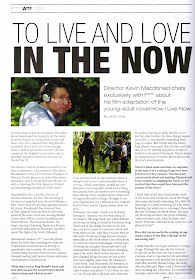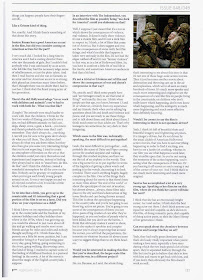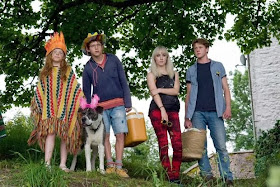TO LIVE AND LOVE IN THE NOW
Director Kevin Macdonald chats
exclusively with F*** about his film adaptation of the young-adult novel How I Live Now.
By
Jedd Jong
Scottish director and documentary
filmmaker Kevin Macdonald has stepped into the realm of movies based on young
adult novels with How I Live Now,
adapted from Meg Rosoff’s acclaimed novel. The director won an Academy Award
for One Day in September, a documentary
film about the massacre at the 1972 Summer Olympics in Munich. He has gone on
to make films about musicians, such as Being
Mick and Marley, as well as Touching the Void, about an ill-fated
mountaineering expedition in the Andes.
Macdonald
is also a prolific director of narrative features, his film The Last King of Scotland earning lead
actor Forest Whitaker a Best Actor Oscar for playing Ugandan dictator Idi Amin.
Macdonald then directed State of Play,
adapted from the British television series of the same name and starring
Russell Crowe, Ben Affleck, Rachel McAdams and Helen Mirren. The historical
drama The Eagle, starring Channing
Tatum as a Roman centurion and based on Rosemary Sutcliffe’s novel The Eagle of the Ninth, followed.
Macdonald
speaks to F*** over the phone about his latest film, touching on what sets it
apart from most movies set during an apocalyptic war scenario, the somewhat
controversial love story between two cousins, talented leading lady Saoirse
Ronan and some uncooperative animal actors.
F***: What drew you
to Meg Rosoff’s book and how did you and the screenwriters decide what to keep
and what to excise?
Kevin Macdonald: I was sent the book by the producer and just thought
that it was a really beautiful piece of writing. I think sometimes, people are
very dismissive of young adult novels and writing, but actually, they can
explore more interesting, more daring, more complex themes than a lot of
supposedly adult writing. I thought it was very original and you could see a
very original kind of “teen movie”, I guess, being made out of it.
Whenever you adapt a book, you’re
always having to…shorten, was the main thing. If you make a 300 page book into
a film without removing anything, it would be five hours long. That’s one of
the things you have to do, but also you have to give it a structure which will
work more in film. And then you also have to find ways of making things that
are interior, especially in this book where a lot of the book is written in interior
monologue, to find ways of making the thoughts that people have and making them
exterior. That means changing quite a lot, and I think in this instance we also
changed things because we cast actors who were slightly older than the
characters in the book. And that meant, for instance, in the book there was an
older brother and that older brother was about 17, but when we cast a 17 or 18
year old in the lead role, there was no point in having an older brother so we
lost the older brother. So those things happen inevitably as you transfer
something from page to screen. But I think also the author, Meg Rosoff, very
much likes the film and feels that it’s a very faithful adaptation in that it’s
faithful to the spirit of the book. There’s always an interpretation of course,
there’s always the director’s interpretation.
There’ve been
some murmurs in response to the aspect of a coming of age love story between
two first cousins. Was there any conversation about not making Edmond and Daisy
cousins in adapting the book, or did you feel that that would have betrayed the
essence of the story?
I think that would have betrayed the truth of the
book, and I think it’s one of the things that makes the book interesting. It’s
a little bit shocking, it’s a little bit daring, it’s a bit taboo-breaking, but
when you’re a teenager, those are the sort of things you think about. You may
not be acting on them, but you’re thinking “what are these rules, what do these
rules mean? What am I allowed to do, what am I not allowed to do?”
How did you
reconcile the coming-of-age drama aspect of the film with that of the oncoming
war?
I think that the war is part of Daisy’s coming of age.
Through the war, she has to learn to survive on her own, she has to learn to
evaluate what is important in life and what’s not important in life and she has
to learn to look after another human being, she looks after the little girl,
Piper. And I always saw the story as being like a fairytale. It’s a modern-day
fairytale, and in fairytales, often rather terrible things can happen: people
have their fingers cut off…
Like a Grimm
kind of thing.
Yes, exactly. And I think there’s something of that
about this story.
Saoirse Ronan
has a good American accent in the film, but did you consider casting an American
actress for the part?
I very much did. I looked for a long time in America
and I had a casting director there who saw thousands of girls. But I couldn’t
find anybody who I was convinced by as an actor, who felt like they had the
necessary edge; sense of rebelliousness, or just the plain talent. And then I
read Saoirse and she was so fantastic as an actor and her American accent is so
strong, she’s played an American many times before, that I thought there was no
doubt that I had to cast her. I think she’s the finest young actor of her
generation.
There’s the
old Hollywood adage “never work with children and animals”; you’ve had to work
with both for How I Live Now. What
was that like?
(Laughs) The animals were much harder to work with
than the children. I think for the first two weeks of filming, practically
every day, we had different animals: we had cats, dogs, sheep, cows, a goat, a
hawk…you know and there’s probably other ones that I can’t remember. They don’t
always do…one thing I can tell you for sure is the goats don’t always do what
you tell them. The children don’t always do what you ask them either, but they
also then give you some very interesting things that you’re not expecting. I
tried to create an atmosphere of freedom on the set so that the children could
just enjoy themselves and experiment and improvise, instead of feeling they
always had to stick to “stand here, do this, do that” and I think the children
created a wonderful atmosphere for all the crew on the film. Nobody can be grumpy
or unpleasant when you’ve got such lovely young people around on set. It was a
very happy set and we all enjoyed ourselves a lot; it was like a little family
in the countryside.
To tie into
that a little, you grew up in the countryside and it’s interesting that a good
portion of the film is set on a farm. Did you draw on your experience as a
child?
I think I drew on my experiences growing up in the
countryside and the freedom of my summer holidays and other holidays there
where in the 1970s, when I was growing up, you would be allowed to just roam
about all day and go walking and maybe meet some friends and go for miles and
miles and nobody thought anything of it. I think these days, parents are a
little bit more cautious, but I can remember being 8 or 9 and just being gone
every day, going fishing, going swimming in the rivers, going walking,
discovering caves, that kind of thing. I wanted to capture some of that feeling
of childhood freedom in a pastoral (setting) in the movie. A lot of the movie
is about the magic of the English countryside, I suppose.
In an
interview with The Independent, you described the film as possibly being “too
dark for America”: could you elaborate on that?
Well, I suppose I just meant that it’s a movie which
shows the consequences of violence, real violence. It doesn’t really show
violence, it’s not a violent film, and it’s not a dark film in respect to, I
think, a lot of films that come out of America. But it does suggest and you see
the consequences of some really horrible things, and what’s horrible that
happens is taken very seriously in the film. It’s not had the edges rubbed off
and it’s not “fantasy violence” in that way, as in a lot of Hollywood films.
So, you have to confront a little bit of real life in the movie, and sometimes
American audiences find that a bit hard.
It’s not a
trivial or frivolous sort of film and shows the consequences of war and doesn’t
compromise in that way?
No, exactly, and I think some people have said “are
teenagers ready to see that kind of thing?” and exactly, they are. I think when
people are that age, you know, between 13 and 21 or whatever, certainly from my
experience and my friends, that’s when you’re asking big questions about life
and death and violence and peace, and you are ready to see those things and to
talk about them and think about them, I think much more so than adults are.
That’s why teenagers can sometimes be very dark in their imagining.
Which scene
in the film was, technically-speaking, the most difficult to put together?
Gosh, the most difficult to put together…well,
probably the scene of Daisy and Piper coming across the crashed airplane and
walking through this crashed airplane, and here we see the tail of an airplane
in the woods. That was a big scene for us to put together in terms of the
logistics of getting a plane wreck and putting it in the woods, decorating it
to look wrecked. There wasn’t anything hugely, hugely complex in the film. One
of the things that’s interesting about the movie is that there’s been so many
films about “the end of the world” or about the apocalypse of one sort of
another, but almost always…always, those films take place in the city and
there’s destruction of big tower blocks and cars being thrown around. This film
is about the apocalypse happening in the countryside, and you’re not going to
see those big, action set pieces. You’re going to see some of the consequences
of them: you see drive-pasts of big crashes of cars after they’ve happened, or
you see bodies of people who’ve been killed, but you don’t see the battles. I
think that obviously makes it easier to shoot, but it also makes it spookier
and creepier because you’re always expecting that around the corner, you will
find the perpetrators, the terrorists or whatever because it’s always more
scary to suggest things than to see them head-on.
Would you be
interested in making this film that you’ve described, the larger-scale film
about the war, in a different project?
No, no. Because, as I said, the whole
thing that’s interesting to me about this story is that it’s not one of those
huge-scale action movies. Then it just becomes another movie about destruction
and throwing cars up in the air and explosions, which we’ve all seen so many
hundreds of times. It’s much more spooky and much more interesting and original
to see the consequences of a war like this on people living in the countryside,
on children who don’t really know what’s happening, don’t even know what’s happening,
and the ambiguity is much more frightening and much more effective than
definitely knowing.
Would I be
correct to say the film is interesting in that it is not spectacle-driven?
Yeah, I think it’s full of beautiful shots and
beautiful imagery and frightening set pieces, it is imagery-driven, but it’s
not driven by the usual clichés of American Hollywood action movies, that you
have to see everything happening in order to find it exciting, you have to see
a jumbo jet crashing, whereas in our film you see what happens a week later,
they stumble upon that. So you’re not seeing the moments of the action
happening, you’re seeing what the consequences of that are. Or you hearing it
off-screen or you’re seeing it out of the corner of your eye. And I think that’s
to me, much more interesting and much more original.
Saoirse has
accomplished a lot at a very young age. Speaking as her director on this film,
where do you think her career will take her next?
I think that she has an enormously bright career. As I
said earlier, I think she’s the best young actor out there. I don’t think
anyone can equal her and she’s capable, as she’s shown in this film, of doing
romantic parts, she’s capable of doing action parts, so she’s the Meryl Streep
of her generation I think.
Can you speak
about the chemistry between Saoirse and George McKay on set?
Yeah, they had really great chemistry and that’s
obviously vitally important when you’re making a love story, especially a love
story during which the two leads spend a lot of time apart, they’re separated
halfway through the film but you’ve got to believe that she’s in love with him
and wants to get back with him, and if you don’t, then obviously the film
doesn’t work so well.










No comments:
Post a Comment
Note: Only a member of this blog may post a comment.